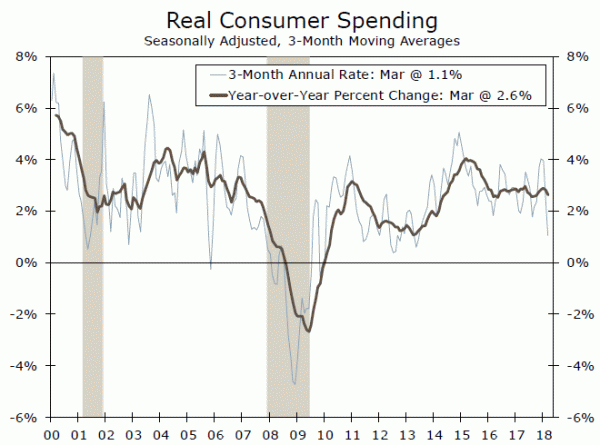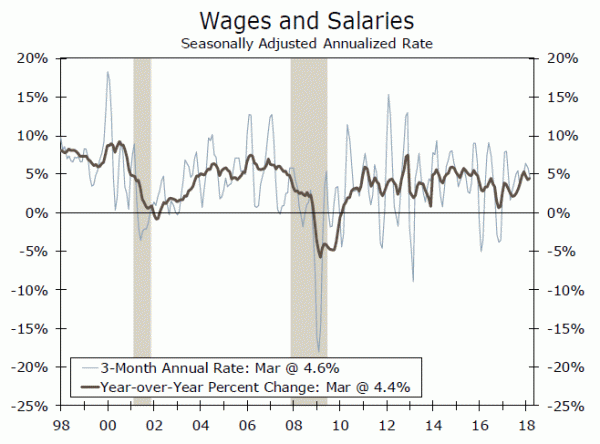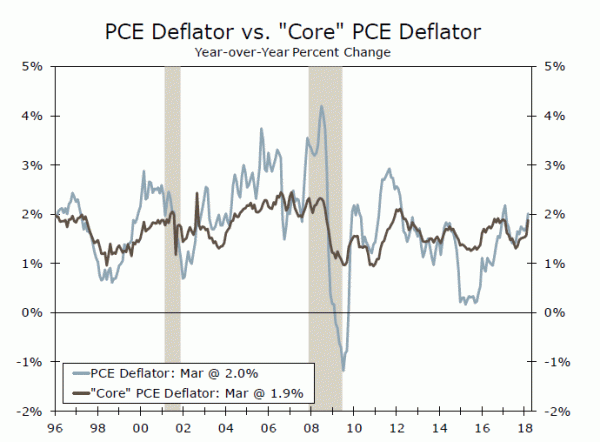After declining in both January and February, consumer spending bounced solidly in March, rising 0.4 percent. Personal income rose slightly less, climbing 0.3 percent, causing the saving rate to slip back to 3.1 percent.
Consumer Spending Looks Set to Perk Up This Spring
First quarter real GDP data had already revealed that consumer spending fell into a bit of a winter slumber during the first quarter. This March data reveal how spending ended the quarter and provide a look into how muchmomentum consumer spending is likely to carry into the second quarter.
Real personal consumption outlays declined in both January and February, dipping 0.1 and 0.2 percentage points, respectively, before rebounding 0.4 percent in March. With all the strength coming at the end of the quarter, real personal consumption expenditures would come close to matching their first quarter’s paltry 1.1 percent pace even if outlays were unchanged in April, May and June. Such an outcome seems unlikely, however, given the strong Q1 pace of job growth, persistently strong readings in consumer confidence, and the arrival of warmer spring weather and tax refunds. Our current forecast calls for outlays to rise at a 2.9 percent pace in Q2, which would require monthly gains in the 0.2 to 0.3 percent rate over the nextthree months.
Early assessments of the first quarter GDP numbers made light of the lack of spark from tax cuts in the consumer spending data. The tax cuts are fairly recent and did trigger a large 0.9 percent gain in the disposable index during January. The bulk of the impact from tax reform is still likely ahead of us, however. Withholding schedules were changed in February and the immediate impact on consumers has likely been fairly small. Larger paychecks will add up over time. Recent consumer surveys show a notableincrease in buying plans for homes, motor vehicles and major appliances.
Consumers should have the wherewithal to boost spending this spring. Wages and salaries rose at a 5.6 percent pace in the first quarter, which was the strongest pace in a year. Wages and salaries ended the quarter on a soft note, however, rising just 0.2 percent. The smaller gain is consistent with the disappointing rise in nonfarm payrolls that month. The monthly data have likely been a little more volatile this year, with harsh winter weather lingering over much of the Northeast and Midwest a little longer than usualand likely keeping consumers indoors during the early part of spring.
Even though the headline PCE deflator was unchanged in March, the yearto- year change ramped up to 2.0 percent in March from 1.7 percent previously. Overall, prices had been held back by lower energy prices and the adoption of unlimited data plans for smartphones. This marks the first time the year-to-year change in the PCE deflator has reached 2.0 percent or more since February 2017. More importantly, the headline PCE deflator has risen at a 2.4 percent pace over the past three months. The core PCE deflator rose 0.2 percent in March and is up 1.9 percent year to year. Both figures are likely to be reflected in the Fed’s policy statement later this week, but are not at thepoint where they would trigger a more aggressive policy response.

















